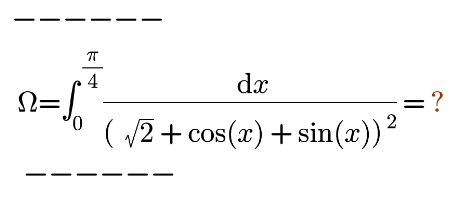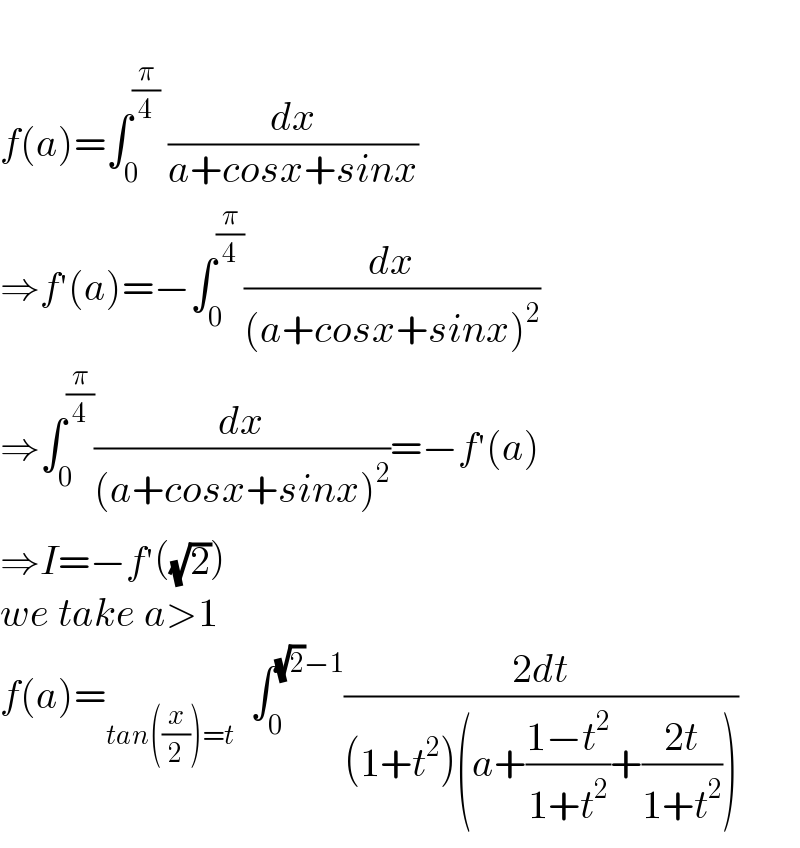
Question and Answers Forum
Question Number 172681 by mnjuly1970 last updated on 30/Jun/22

Answered by Jamshidbek last updated on 30/Jun/22

Answered by Mathspace last updated on 30/Jun/22

Commented by Mathspace last updated on 30/Jun/22
![f(a)=2∫_0 ^((√2)−1) (dt/(a+at^2 +1−t^2 +2t)) =2∫_0 ^((√2)−1) (dt/((a−1)t^2 +2t +a+1)) Δ^′ =1−(a^2 −1)=2−a^2 t_1 =((−1+(√(2−a^2 )))/(a−1)) t_2 =((−1−(√(2−a^2 )))/(a−1)) ⇒ f(a)=2∫_0 ^((√2)−1) (dt/((a−1)(t−t_1 )(t−t_2 ))) =(2/(a−1))×((2(√(2−a^2 )))/(a−1))∫_0 ^((√2)−1) ((1/(t−t_1 ))−(1/(t−t_2 )))dt =((4(√(2−a^2 )))/((a−1)^2 ))[ln∣((t−t_1 )/(t−t_2 ))∣]_0 ^((√2)−1) =((4(√(2−a^2 )))/((a−1)^2 )){ln∣(((√2)−1−t_1 )/( (√2)−1−t_2 ))∣+ln∣(t_2 /t_1 )∣} rest to calculate f^′ (a)...be continued...](Q172728.png)
Answered by Mathspace last updated on 30/Jun/22
![Φ=∫_0 ^(π/4) (dx/(((√2)+(√2)cos(x−(π/4)))^2 )) =(1/2)∫_0 ^(π/4) (dx/((1+cos(x−(π/4)))^2 )) =_(x−(π/4)=−t) (1/2)∫_(π/4) ^o ((−dt)/((1+cost)^2 )) =(1/2)∫_0 ^(π/4) (dt/((1+cost)^2 )) (tan((t/2))=y) =(1/2)∫_0 ^((√2)−1) ((2dy)/((y^2 +1)(1+((1−y^2 )/(1+y^2 )))^2 )) =∫_0 ^((√2)−1) (dy/((y^2 +1)((2/(1+y^2 )))^2 )) =∫_0 ^((√2)−1) ((1+y^2 )/4)dy =(1/4)((√2)−1)+(1/(12))[y^3 ]_0 ^((√2)−1) =(((√2)−1)/4)+((((√2)−1)^3 )/(12))](Q172729.png)
Commented by Tawa11 last updated on 01/Jul/22

Answered by mr W last updated on 30/Jun/22
![cos x+sin x=(√2) cos (x−(π/4)) Ω=∫_0 ^(π/4) ((d(x−(π/4)))/(2(1+cos (x−(π/4)))^2 )) Ω=∫_(−(π/4)) ^0 (dt/(2(1+cos t)^2 )) Ω=(1/4)∫_(−(π/4)) ^0 ((d((t/2)))/(cos^4 ((t/2)))) Ω=(1/4)∫_(−(π/8)) ^0 (du/(cos^4 u)) Ω=(1/4)[tan u+((tan^3 u)/3)]_(−(π/8)) ^0 Ω=(1/4)tan (π/8)(1+(1/3)×tan^2 (π/8)) Ω=(((√2)−1)/4)(1+((((√2)−1)^2 )/3))=((4(√2)−5)/6) ✓ tan (π/4)=((2tan (π/8))/(1−tan^2 (π/8)))=1 ⇒tan (π/8)=(√2)−1](Q172739.png)
Commented by Tawa11 last updated on 01/Jul/22

